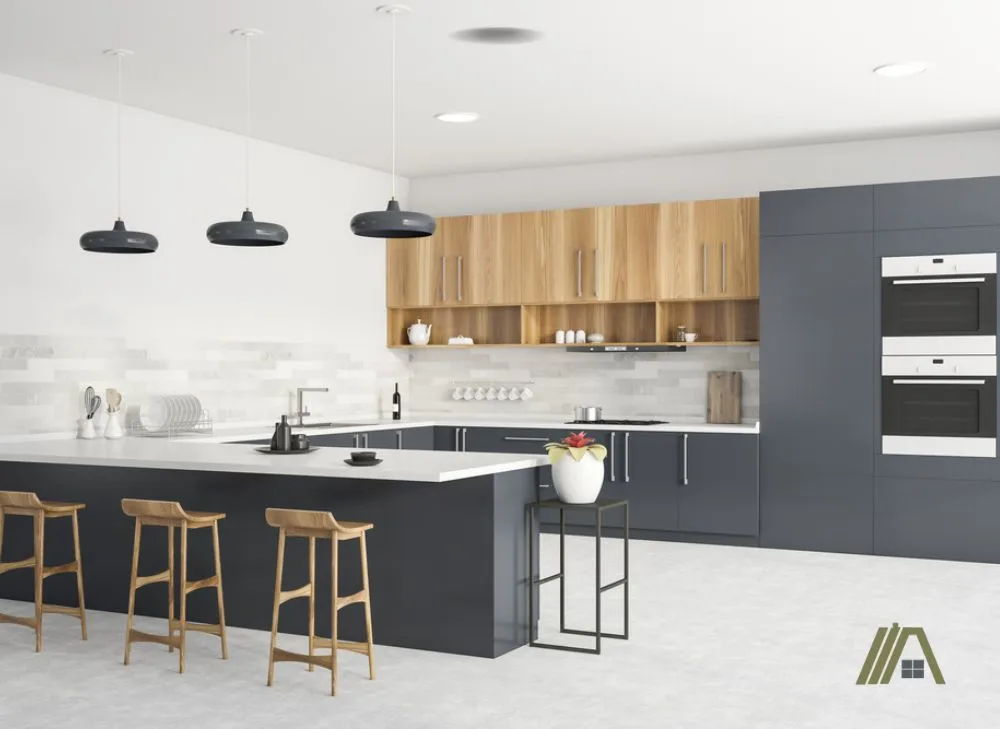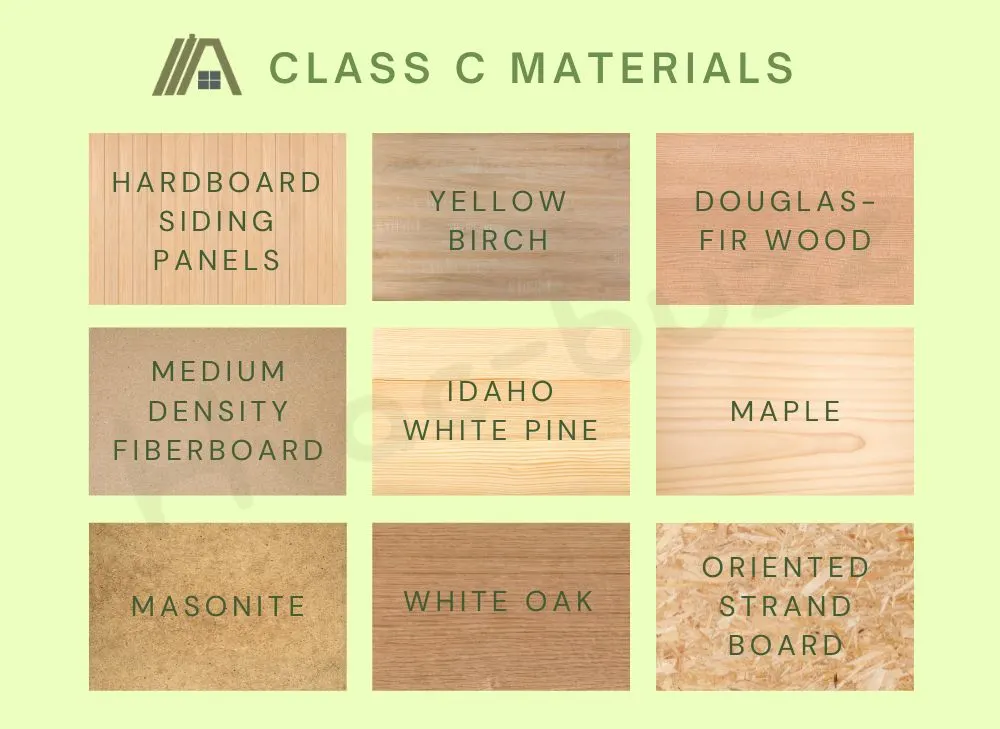Your kitchen is a space that comes into contact with a lot of heat from various sources. While no one wants to think about their stove or microwave catching alight, accidents do happen.
If they do, you would want your home to be as protected as possible to limit the amount of damage that could occur. If the flames reach the ceiling, they could spread to the roof and travel along to the rest of the house.

Kitchen ceilings do not need to be fire-rated, although they would benefit from Class C ceiling materials. Sprinkler systems are required no more than 18" from ovens or range hoods.
No Requirements in the IRC
The International Residential Code (IRC) regulates one- and two-family dwellings (Section R101.1). There are no specific or clear requirements in the IRC that dictate that a kitchen ceiling needs to be fire rated.

When it comes to fire safety, Section R302 of the IRC outlines fire-resistant construction (such as sprinkler systems), but it doesn’t mention any specific requirements for kitchen ceilings.
Interior Finish Fire-Ratings in the IFC
There is another code that comes into play here and that is the International Fire Code (IFC).
According to Table 803.3 of the IFC, all rooms and enclosed spaces (kitchens meet this description) in occupancies classified as R (residences), Class C (or Class 3 or Class III) fire resistant materials are required to finish the space.
Technically, Section 102.5 of the IFC states that only the “construction and design provisions [of the IFC] pertaining to the exterior of the structure” apply to residences that are otherwise covered by the IRC. So, the regulations and provisions outlined for the interior of homes as set out in Section 803.3 of the IFC are not actually included.
However, you will probably find that your kitchen will likely be made out of fire-resistance materials anyway. There are a variety of ceiling materials that people often use, that actually fall into this fire-rating class.
Therefore, if your house does not specifically fall into the category governed by the IFC, you can know that using these materials makes your kitchen ceiling as fire-resistant as is considered to be safe in a kitchen.
What Does Class C Fire-Rating Mean?
Materials that are classified as Class C have a Flame Spread Rating of 76-200.
Basically, this class rating is the degree that a given material is able to stop the spread of flames by creating a protective layer between the fire and a potentially combustible material (such as wood).
The numerical rating is, therefore, how well this product can accomplish this—it is the speed at which the flame can spread across the material.
The lower the rating (the closer to 0), the better the material can sustain a larger and more severe fire. Bricks, cement and tiles are examples of these materials.
Class C materials are protective against light fire exposure, such as a small kitchen fire.
Class C Ceiling Materials Appropriate for Kitchens
When constructing or renovating your kitchen, it is likely that you will be making use of Class C materials. These materials are commonly used not only due to their fire-rating, but also as they are really easy to find and can be relatively affordable, making construction projects budget-friendly.
According to the Louisiana government, Class C materials include:
- Hardboard siding panels
- Yellow birch
- Douglas-fir wood
- Medium density fiberboard
- Idaho white pine
- Maple
- Masonite
- Red or white oak
- Oriented strand board
- Particle board
- Pine (lodgepole or ponderosa)
- Plywood (oak or pine)

Not all of the listed materials are common ceiling materials. White pine is often used on ceilings in Farmhouse-style houses due to the aesthetic quality that it brings to a space. However, most homes may opt for fiberboard or particleboard as they are more affordable options.
Should You Use a More Fire Resistant Material?
A lot of the time, people want to go the extra mile and spend the extra money to ensure the safety of their family and their homes.
While it is not outlined as a necessity or law to have your kitchen constructed out of Class A or B fire-rated materials, there may be benefits of doing so.
More fire-resistant materials may be a good investment for your home. If a fire does happen to occur in your kitchen, the flames will be unlikely to spread to your roof or the upper floors of your home if it is comprised of multiple levels.
A fire-resistant ceiling could be the difference between having to renovate your kitchen, or having to salvage your entire home.
However, some experts do say that exceeding the recommended Class C rating might be futile. While your house may be safer from a potential fire spreading upward, these higher rated materials aren’t always the greatest idea.
If you installed better fire-resistant ceilings, the only way to make them truly beneficial to your home would be to close off any openings or routes that fire could potentially travel through, such as doors, windows, ducting, etc.
This would need to be done because if there was a fire and it tried to spread on the ceiling, it would not be able to. It would then look for another source of oxygen, through open doors, windows, and ducts (like your range hood).
If you simply had the stronger ceilings, and did not close off any openings, the fire would just spread to the rest of your home laterally as opposed to vertically (although it would also go vertically when it reached a non-fire resistant ceiling), and the large chunk of money you forked out would prove to be a waste.
Code-Regulated Fire Protection: Sprinkler Systems
The IRC has outlined more specifications that homeowners would need to comply with that ensure the safety of their homes.
Table P2904.1.1 of the IRC regulates where a homeowner would need to install a sprinkler system in their kitchen; a system that would be able to detect temperatures of at least 175 °F. The sprinklers would go off as soon as a certain amount of heat is detected, extinguishing any possible fires.
This section of the IRC dictates that one would need to have a sprinkler system no more than 18″ away from an oven or range hood. Make sure your kitchen ceiling fan does not interfere with this if you have one. Ceiling fans cannot be within three feet of pendent sprinklers and five feet of sidewall sprinklers.
Sources
https://kanopibyarmstrong.com/blogs/news/fire-rated-ceiling-tiles
https://www.thisoldhouse.com/walls/21173181/fire-rated-drywall
https://inspectapedia.com/interiors/Fiberboard-Ceilings-Walls.php
https://www.thespruce.com/nstall-tongue-and-groove-wood-ceiling-1821438

